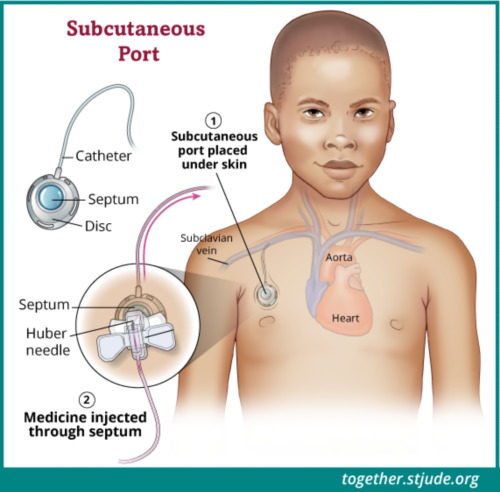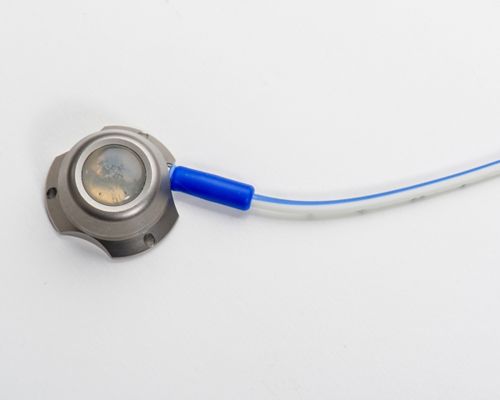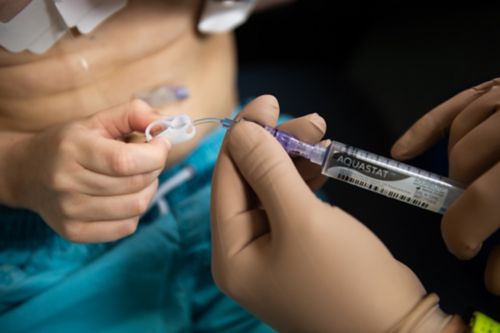What is a subcutaneous port?
A subcutaneous port is a central venous catheter (central line) located completely under the skin. The port is located just under the skin, usually in the chest. It is a small disc with a raised center. The catheter is attached to the base of the port and extends into the vein. The center of the disc, called a septum, is a raised area made of rubber.
Medicines or other fluids are injected into the septum and travel through the catheter to the vein. The port may have 1 or 2 access points (single lumen or double lumen).
Medicine is given through the port using a special needle, called a Huber needle. A numbing cream can be used over the area before needle sticks. This device is also known as a port-a-cath, implantable port, or subcutaneous infusaport.
The port is located just under the skin, usually in the chest. It is a small disc with a raised center. The catheter is attached to the base of the port and extends into the vein. The center of the disc, called a septum, is a raised area made of rubber. Medicines or other fluids are injected into the septum and travel through the catheter to the vein. The port may have 1 or 2 access points (single lumen or double lumen).
Placement of a subcutaneous port is a common procedure and has important benefits for patients and families. However, there are always risks involved with anesthesia and surgery. The main risks during insertion include bleeding, puncture of a lung or blood vessel, blood clots, irregular heartbeat, nerve injury, and infection. After line placement, blood clots, movement of the catheter out of position, and infection are the most common complications. Surgery is also needed to remove the port.
Serious complications are rare, but they do occur. Be sure to ask questions and follow all instructions given by the care team.
Placement of an implantable port
Children will receive general anesthesia for port placement. They will not feel pain or be aware during the procedure. Patients will be given NPO instructions for limiting food and drink before the procedure. It is very important to follow these guidelines. The total time for the procedure is usually about 1-2 hours with anesthesia and recovery.
- Before the procedure, patients will have blood work and a physical exam. Members of the care team will meet with the family to complete paperwork and answer questions.
- The patient will be taken to an operating room for the procedure. Depending on medical center policies, a parent may be able to go with the patient until time for the placement.
- Children receive general anesthesia for central line placement. Heart rate and blood pressure will be monitored throughout the procedure and recovery.
- The skin in the area will be cleaned, and a drape will cover the patient to keep the area clean and help prevent infection.
- The vein will be located using ultrasound imaging or anatomical landmarks. A very small cut will be made in the skin near the collarbone or neck.
- A second cut about an inch long will be made in the upper chest. The doctor will create a space, or pocket, under the skin for the port. A small tunnel for the catheter will be made.
- The catheter will be guided from the port and through the vein under X-ray guidance until the tip reaches its proper position near the heart.
- The port will be remain in the space under the skin, and the incisions will be closed with stitches.
- An X-ray will be used to check the position of the catheter and port and to make sure the lung was not injured (pneumothorax) during the procedure. The port will be tested to make sure it is working properly.
- Patients will be taken to a recovery room. Patients will be monitored during this time. Recovery from port placement usually takes about an hour. If a port placement is the only procedure, patients may leave the hospital after recovery. A nurse will go over at-home care.
Caring for a subcutaneous port
Your care team will teach you how to care for the subcutaneous port. The port must be flushed every 4 weeks with heparin. Heparin is a medicine that keeps the blood from clotting and blocking the line. During treatment, a needle will be placed to access the port, and a dressing will be worn over the area. The needle must be changed every 7 days, and the dressing must be kept clean and dry. When the port is not in use, the needle is removed and patients can do most daily activities.
Always follow your care team's instructions for how and when to care for your child's port.
What to expect
Early healing
The area will be sore for a few days. There will be a few stitches where the incision was made. There may be some swelling or bruising in the area. You child should avoid strenuous activities for 6 weeks or until advised by a doctor.
Getting medicine
There will be a “poke” when the catheter is accessed using a Huber needle. Medications may be given with a syringe or an IV bag. Let a nurse know if your child has any pain or discomfort while getting medications.
General care
Follow all care instructions to keep the line working properly and to prevent infection. Avoid activities such as contact sports that might cause impact to the port area.
A Central Line Associated Blood Stream Infection (CLABSI) can be life-threatening. Call your doctor at any sign of infection such as pain, redness, swelling, or fever.






